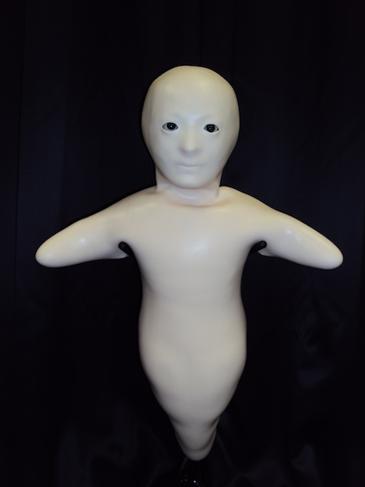A Strange New Take on Telepresence
Many telepresence robots–like Anybot and Texai–resemble a teleconferencing system on wheels. Roboticist Hiroshi Ishiguro, who has previously created some unnervingly realistic humanoid machines, has a different idea. His newest and arguably most unsettling robot yet is Telenoid, which resembles a barely-formed robotic child, with a soft body, clay-like face and stubs instead of limbs.

Ishiguro explains that Telenoid is meant to represent a human presence, and could be used for remote work, teaching or conversation. Unlike other telepresence bots, he says, Telenoid is able to be hugged and handled while a user is talking to a remote acquaintance.
The researchers write on the project’s research page:
Telenoid R1 was designed to appear and to behave as a minimalistic human; at the very first glance, one can easily recognize the Telenoid as a human while the Telenoid appear as both male and female, as both old and young. By this minimal design, the Telenoid allows people to feel as if an acquaintance in the distance is next to you.
To operate Telenoid, a user uses a webcam and custom telepresence software. A tracking system tracks the user’s head movements and voice. Eager Co. Ltd will distribute research and commercial versions of the robot by the end of the year.
Watch a video of Telenoid in action below:
Keep Reading
Most Popular
Large language models can do jaw-dropping things. But nobody knows exactly why.
And that's a problem. Figuring it out is one of the biggest scientific puzzles of our time and a crucial step towards controlling more powerful future models.
The problem with plug-in hybrids? Their drivers.
Plug-in hybrids are often sold as a transition to EVs, but new data from Europe shows we’re still underestimating the emissions they produce.
Google DeepMind’s new generative model makes Super Mario–like games from scratch
Genie learns how to control games by watching hours and hours of video. It could help train next-gen robots too.
How scientists traced a mysterious covid case back to six toilets
When wastewater surveillance turns into a hunt for a single infected individual, the ethics get tricky.
Stay connected
Get the latest updates from
MIT Technology Review
Discover special offers, top stories, upcoming events, and more.